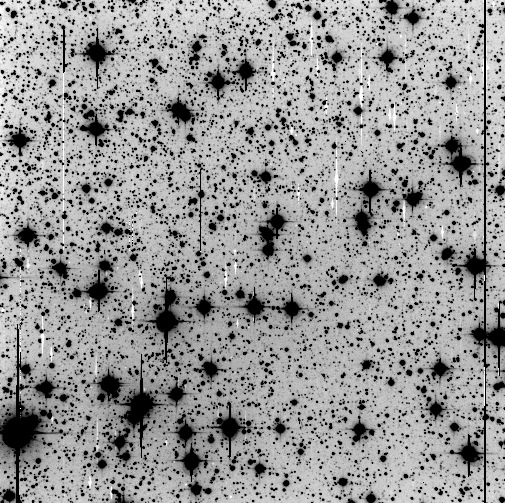

SMARTS 0.9-meter telescope web page [1]
The SMARTS 0.9-meter telescope is a Cassegrain telescope mounted on an off-axis, asymmetric mounting and used on the east side of the pier. As of August 2020 the 0.9m is used for direct imaging with a dedicated 2048x2046 CCD detector. A CCD-based autoguider, which looks at a small off-axis field, is permanently installed. The 0.9-m has been operated by the SMARTS Consortium since 2003 FEB 01.
Classical observing only. In special circumstances some service observing may be possible. Contact Todd Henry for information.
Since (at least) 1999, the 0.9-m has been equipped with a dedicated 2048x2046 Tek2K CCD detector. Please refer to the Tek2K instrument page [2] for CCD characteristics.
Note that visitor instruments have been used at the 0.9-m for engineering, which provides a telescope amenable to many imaging applications.
There are two stacked filter wheels at the 0.9-m. The top wheel includes a color balance filter (for dome flats), neutral density filters, and open slots. The bottom filter wheel slot can hold wheels with 3x3 inch filters (up to 8 filters, typically at least BVRI) or 4x4 inch filters (up to 5 filters, typically ugriz).
See the Filter list [3] for more information on the available filters.
For projects that require accurate timing information, here is a quick overview on how the time ends up in the image headers.
There are two different header entries relating to time, UT and UTSHUT:
UT is read from the TCS. While there is a GPS receiver that displays accurate Universal Time in the 0.9-m console room, this information is currently not communicated to the TCS automatically. Instead, the UT should be checked and manually entered into the TCS at the beginning of each night. The absolute accuracy is therefore at best ~1 sec. The TCS clock may drift slightly during the night and is therefore not reliable for precise absolute or relative timing.
UTSHUT is taken from the Torrent controller's clock, which is synchronized to the (needs updating) ...
To check for the correct UT time on the web, try this link to the USNO Master Clock [4].
Tek2K is a 2K optical CCD imager installed on the SMARTS 0.9-meter telescope that provides a 13.6 arcminute field of view with 0.4 arcsecond pixels. Key capabilities of the imaging system at the 0.9-m can be found at http://www.astro.gsu.edu/~thenry/SMARTS/0.9m.capabilities [5].
| Detector Parameters (f/13.5) | |
| Pixels | 2048x2046 |
| Pixel Scale | 0.401"/pixel |
| Field Size | 13.6'x13.6' |
The observer can control and change the CCD readout format and binning. The entire chip can be read out via a single amplifier, or to reduce the readout time, two (DUAL mode) or four (QUAD mode) amplifiers can be used. The region-of-interest (ROI) can also be adjusted to use an arbitrary section of the CCD. Observers should think carefully about whether or not they need the entire field (if not, read a ROI) or the resolution (if not, bin 2x2) because substantial gains in efficiency are possible by reducing the format or increasing the bin size.
A raw quad-amplifier picture looks a little unusual. Each quadrant has a slightly different electrical offset (ie overscan level), and the four overscan segments are in the center of the picture. The real time display colors any saturated (i.e., 65535 ADUs) pixel in red.
QUAD CCD pictures have to be trimmed and overscan-subtracted in a separate pre-processing IRAF task called quadproc (in the quad package). Note that even after the pictures are trimmed and overscan subtracted, the sky levels in each quadrant will not be identical (unless the sky level is zero). This is because each of the four CCD amplifiers has a slightly different gain. After the trimming and overscan correction with quadproc, the images can be processed (bias subtraction, flatfielding) in the standard manner.
A night assistant is not provided at the SMARTS 0.9-meter telescope. An Observer's Manual, including details about the telescope, instrument, telescope control system, and data acquistion system is provided in the observing room and at http://www.astro.gsu.edu/~thenry/SMARTS/ [1].
Sky flats and dome flats can be taken. Dome flat exposure times to reach a level of about 25,000 ADU are:
| Filter | Exp Time (sec) |
| B | 180 |
| V | 100 |
| R | 110 |
| I | 120 |
When using multiple-amplifier readout, the signal from one amplifier can "leak" into the signal of another. Crosstalk is an additive effect and is proportional to the signal strength in a given amplifier. In the sample frame shown below, this effect shows up as negative (white) images of bright stars in the lower left and upper right quadrants. The white images in the upper right quadrant correspond to the (black) star images of the lower left quadrant (flip the upper right quadrant left-right and up-down).
 [8] [8] |
A reduced 2048x2048 frame (quad readout) showing examples of "crosstalk" (click on the image for an expanded view).
|
Links
[1] http://www.astro.gsu.edu/~thenry/SMARTS/
[2] http://www.ctio.noao.edu/noao/content/Tek2K
[3] http://www.ctio.noao.edu/noao/content/ctio-3x3-inch-and-4x4-inch-filters
[4] http://tycho.usno.navy.mil/what1.html
[5] http://www.astro.gsu.edu/~thenry/SMARTS/0.9m.capabilities
[6] http://www.ctio.noao.edu/noao/sites/default/files/telescopes/smarts/tele09/0.9zero.jpg
[7] http://www.ctio.noao.edu/noao/sites/default/files/telescopes/smarts/tele09/0.9vflat.jpg
[8] http://www.ctio.noao.edu/noao/sites/default/files/telescopes/smarts/tele09/0.9crosstalk.jpg